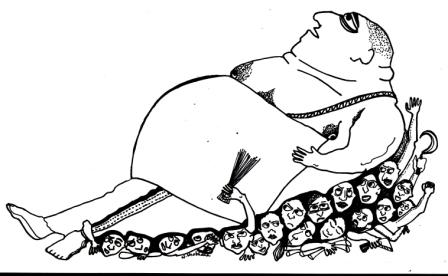Hany Babu MT
The letter dated 5 March 2018 from the University Grants Commission (UGC) to the higher educational institutions regarding the implementation of reservation in teaching posts has once again made it abundantly clear that those who are at the helm of affairs in the Ministry of Human Resources (MHRD) and the UGC have scant respect for the principles of social justice.

‘Reservations’: Illustration by Nidhin Shobhana
The said letter requires universities and colleges to prepare their reservation roster “keeping the department / subject as a unit for all levels of teachers”, which is in contravention to the previous circular from UGC dated 2006, where it was recommended that the roster should be prepared by taking the college/university as a unit. In fact, the 2006 circular (which is called “UGC Guidelines for Strict Implementation of Reservation Policy”) clearly state that
The practice of creating department-wise cadres, which tends to create single posts or cadres with artificially reduced number of posts in order to avoid reservation, is strictly forbidden.”
The basic difference between the two methods of preparing the roster is as follows: If we take the College / University as a unit, all the faculty members of the same rank are taken together and a 200 point roster is applied, so that percentage of reservation earmarked for each category is fulfilled, i.e. 27% for the Other Backward Classes (OBC), 15% for the Scheduled Castes (SC), and 7.5% for the Scheduled Tribes (ST). But if department/subject is taken as a unit, 200 point roster will apply only to those departments that have a strength of 14 or more faculty members. A 13-point roster is to be applied to the departments or subjects with less strength.
To take an example, a prominent college of the Delhi University has 170 teachers in the cadre. According to the 200-point roster, the college has 62 posts for OBC, 34 for SC, and 17 for ST. But if the subject is taken as a unit, only 8 subjects have 14 or more teachers while 7 subjects have less than 14 teachers. There are 60 posts in the 7 subjects with less than 14 teachers. If those 60 posts are placed on the 200-point roster there should 16 posts for OBC, 9 posts for SC, and 4 posts for ST. The total number of posts for the reserved categories will be 29, i.e. 48.3% of 60. (It should be borne in mind that the required percentage of reservation is 49.5%.) Now, if the 13-point roster is applied to each department, there will be only 12 posts for OBC, 5 posts for SC, and not a single post for ST. The total number of posts for reserved categories will be 17, i.e. 28.3% of 60. It is evident why UGC in 2006 thought that department wise or subject wise rosters will artificially reduce the number of posts. It is true that the 13-point roster if it is allowed to run through its entire cycle, which requires more than 10 cycles, will attain the requisite percentage. But it takes 10 generations to achieve that. The promise of social justice has been illusory even after seven decades since the transfer of power. Asking the socially and educationally underprivileged classes to wait for another 10 generations is definitely not a right step to take.
In fact, this is not the first time that the UGC has abandoned the strong position that they had initially taken in support of the socially disadvantaged sections of the society. In a notification in May 2016 on maintaining minimum standards and procedure of award of MPhil/PhD, UGC stipulated that admission to the research programs shall be through a two-stage process involving an admission test and an interview and that the admission test shall be qualifying (with 50% as the qualifying marks). This means that once a candidate has qualified, her admission depended solely on the marks awarded in the interview. This had lead to large-scale protests in various universities. The argument of the protesters was that given the highly prejudicial system that prevailed in most of the Indian universities, students (especially from the marginalized sections) would become extremely vulnerable as their fate depended on the marks awarded in the interview, the objectivity of which was highly debatable. This was a marked departure from the position taken by the UGC as expressly mentioned in a circular dated 1989:
The Entrance test is not a qualifying test. The qualifying examination is the examination which a candidate has passed at the lower level of the education has already qualified in a duly conducted qualifying examination. The purpose of the Entrance test is only to arrange the candidates in inter-se merit especially in the context that candidates come from different sources and from different streams, often from a different part of the State or different parts of the country with different standards or evaluation.”
UGC gave no rationale for changing the earlier position, which was again taken to safeguard the students’ interest. However, in the instant case, the UGC has stated that the current move to make the roster department/subject-wise is initiated following a letter from the Ministry of Human Resource Development dated 6 September 2017, which directed the UGC to examine the issues raised in the judgment of the High Court of Allahabad dated 7 April 2017. It has to be noted that the judgment of the Allahabad High Court was pertaining to the roster prepared by the Benares Hindu University, which was according to the 2006 UGC guidelines. The Allahabad High Court quashed not only the BHU roster and advertisement, but also struck down the provisions in the UGC guidelines that recommended making the roster by taking the college/university as a unit.
There are a couple of things that strike us. The 200-point roster was mandated by the judgment of the Supreme Court in the case of RK Sabharwal, which was delivered in 1995. It is only after 11 years (i.e. in 2006) that the UGC formulates its guidelines to prepare the 200-point roster. In fact, the University of Delhi, one of the largest central universities in India, implemented the 200-point roster only in 2013, i.e. 18 years after the RK Sabharwal judgment. The Allahabad High Court delivers the judgment striking down the 2006 UGC guidelines in April 2017. In five months’ time (i.e. in September 2017), the MHRD writes to the UGC to look into the issue and in less than a year’s time (i.e. in March 2018), the UGC has issued a directive to all the universities to change its roster. And this has to be complied within a month’s time. Of course, one should not look at the intent if the authority is acting according to law. However, the hurried manner in which they acted after the judgment of Allahabad High Court does raise a question about their commitment to social justice.
There could a lot of quibble about the technicalities involved in the Allahabad High Court judgment. For instance, the crux of the matter is how “cadre” is defined. While the UGC in 2006 had taken the view that “cadre is best indicated by seniority list governing the members with the same pay-scale”, the Allahabad High Court has taken the question of “interchangeability” between posts a crucial factor. That is to say, a Professor of Physics cannot be substituted with a Professor of Philosophy, and therefore they have to be treated as belonging to the different cadres. However, this seems to be an academic issue, and not an issue that governs the service conditions and or the relationship between the employer and employee. In terms of service conditions, all teachers of a rank are governed by the same rules and are required to perform duties of the same nature. In academic fields where the number of posts is low, it makes no sense to take a narrow view of how cadre is to be defined.
Moreover, posts are not sanctioned subject wise. UGC sanctions a number of posts to the colleges and it is left to the authorities of the colleges to distribute the posts to the subjects depending on various factors like the number of students. There is a lot of flexibility in the distribution of posts across subjects and they are quite often shifted from subject to subject as per the needs of a given year or semester. If rosters are to be maintained subject-wise, it is not clear whether and how colleges can exercise this freedom.
Another aspect of the judgment is that many of the judgments cited by the High Court do not require the reservation roster to be maintained subject wise or department wise. What the Apex Court has consistently maintained in many of its judgments (like Suresh Chandra Verma vs. Chancellor, Nagpur University) is that the advertisement should make clear the department wise reservation of posts. That is to say, if an advertisement is given for a specific number of posts, it should be made clear which are the reserved posts. Thus, the Supreme Court has quashed advertisements that do not specify which are the reserved posts. There is a good reason to do this. For one thing, the interview committee should know clearly whether they are interviewing candidates for a reserved post or not. For the candidates also it should be clear whether they are competing for open posts or for reserved posts. The 200-point rosters prepared by BHU and the University of Delhi had incorporated ways in which department wise reservation can be built into the 200 point roster even when all the departments are placed on a single roster. While social justice groups have been carrying out fights to rectify the anomalies in such rosters, they suddenly find that the very turf on which they are standing is taken away from under their feet. It only shows that the path towards social justice is getting more and more arduous and the struggles should be more concerted.
~~~
Hany Babu teaches in the Department of English, Delhi University, and is Secretary, Academic Forum for Social Justice. He can be contacted at: hanybabu@gmail.com









